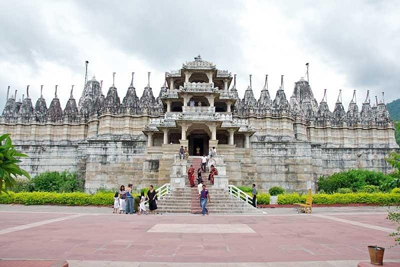
Nestled in a tranquil atmosphere amidst the rugged terrains of the Aravalli Range in Rajasthan, and located in the village of Ranakpur, around 90 kilometres from the city of Udaypur, Ranakpur Jain Temple, dedicated to Adinath or Rishabhanatha, the first Tirthankara of Jainism, is one of the largest and one of the major pilgrimage sites for the Shwetambara Jains, one of the two main sects of Jainism. Also known as Chaturmukha Jain Temple or Chaturmukha Dharana Vihara, the stunning white marble temple, constructed in Māru-Gurjara architecture or Solaṅkī style, is renowned for its intricate carvings, detailed sculptures, ornate pillars, vast scale, and unique architectural design. The temple is also considered one of the five holiest Jain Shrines in India and part of Gorwad Panch Tirth, which includes the temple of Ranakpur, along with the temples of Muchhal Mahavir, Narlai, Nadol, and Varkana.

According to Shri Soma-Saubhagya Kavya, a Sanskrit text written by Muni Dharma Vijay and a copper-plate inscription discovered within the temple complex indicate that the construction of the Ranakpur Jain Temple dates back to 1436. However, according to a local legend, inspired by a dream about a celestial vehicle, Dhanna Shah, a prosperous merchant, commenced its construction in 1389, under the sponsorship and guidance of Rana Kumbha, the then ruler of Mewar, who donated the land and also played a crucial role in its construction. An inscription on a pillar located near the main shrine evidences that at the instance of Dhanna Shah, the sketch of the proposed temple, reflecting the image of the celestial vehicle of his dream, was exactly designed by an eccentric ascetic architect Deepak from Mundara in 1439, and was later constructed at the direction of Dharanka, a devoted Jain. It is estimated that the construction of the temple continued until 1458, but according to another source, it took fifty years from 1446 to complete the temple in 1496, and involved as many as 2,785 of craftsmen and sculptors.


Spreading over an area of 48,000 square feet (approx 4459 sq m), and adorned with its distinctive spire, known as shikhara, turrets, and cupolas, the three-storey grand white marble structure of the Ranakpur Jain Temple, majestically rising from the slope of a hill, is supported by 1444 intricately carved marble pillars, containing 29 pillared halls and 80 fascinating domes, borne by 400 columns. Surprisingly, each of the 1444 marble pillars is uniquely carved, has its own individual identity, and none of them looks alike. However, one pillar is kept incomplete and a local legend says that despite taking every possible precautionary measure, it broke down the next morning after the day of its construction. In addition to the aesthetically carved pillars, adorned with delicate lattice work, floral motifs, and figures of nymphs and divine maidens, the ceiling of the temple reveals an immense sea of creativity and skilfulness, bedecked with geometric designs and scrollwork, along with the mesmerisingly beautiful nymphs and enigmatic heavenly maidens playing musical instruments, at the height of nearly 45 feet.

The sanctum sanctorum of the temple, called Garbhagriha, houses a 6-feet tall white idol of Lord Adinath in the form of Chaumukha, with four heads facing in four directions. The temple also contains a beautiful idol of Parshvanatha, the 23rd Tirthankara of Jainism, carved out of a single slab of marble, under the hood of a 108-headed snake with numerous tails, and flanked by two yakshas and yakshins. Interestingly, Ranakpur Jain Temple is equipped with 84 Bhonyra or underground chambers to hide the holy Jain idols from any possible attack by the Mughals. The four openings of the sanctum, symbolic to the Chaumukha form of Adinath, lead to the Ranga Mandapa or the Dancing Hall, while the prayer hall of the temple boasts two mammoth bells weighing 108 kg each.

The entire complex of the Ranakpur Jain Temple is surrounded by a wall enclosing three other smaller Jain temples, which include the temple of Parshvanatha Temple, dedicated to Parshvanatha, the 23rd Jain Tīrthankara, located next to the entrance of the main Chaumukha temple, and incredibly rich in decorations, especially known for its carved windows. The Neminath Temple, embellished with exquisite carvings, is pretty much resembles a replica of the Parshwanath Temple, while Mahavira Temple, dedicated to Mahavira, the 24th Tirthankara of Jainism, features a huge dome structure with richly embellished pillars and ceiling. Apart from the above, the complex houses the Suparshvanath Temple, dedicated to Suparshvanath, also known as Suparsva, the seventh Jain Tīrthankara. However, there is also the Surya Narayan Temple, popularly known as the Sun Temple or Surya Mandir, dedicated to the Sun God, Lord Surya. Built of white limestone in the 13th century in Nagara style of architecture with intricate carvings, the temple features depiction of celestial bodies, warriors on horses, and Lord Surya riding his chariot.

With its timeless beautiful architecture and spiritual aura, Ranakpur Jain Temple, manifestation of a dream project of Dharma Shah, attracts pilgrims and travellers alike. Every evening after sundown, the Ranakpur temple brims to life with glistening rows of diyas or earthen lamps for the evening aarti, a ceremony of light offered to deity in the evening, creating an unearthly hypnotic sight to be cherished in memory. A visit to the stunning temple, set amidst the serenity of the hilly terrains of the Aravalli Range, is a treat for the eyes, as well as a journey to a sense of spirituality through its aercheological brilliance.